(1) The NYT Sort of Gets It – The Market for Legal Services Meets The Market for Legal Education
 I am a bit torn by all of this. In general, I think the NY Times should be commended for its decision to highlight the problems in the legal education market. While I could flag disagreement with some aspects of their coverage, the basic thrust is so true – major reform of American Legal Education is clearly needed. However, what precise reform should be adopted is where the argument really begins.
I am a bit torn by all of this. In general, I think the NY Times should be commended for its decision to highlight the problems in the legal education market. While I could flag disagreement with some aspects of their coverage, the basic thrust is so true – major reform of American Legal Education is clearly needed. However, what precise reform should be adopted is where the argument really begins.
Here is the iron rule of the law school reform business — platitudes abound and specific proposals are few and far between. When I talk to folks in the legal academy about the state of our business – typically, the response is something akin to this “you know Dan – if only we taught more of my subject area – our students would be much better off.” Seriously, the crazy thing is that folks make the subject area superiority claim almost independent of the subject matter they teach (for example – even Con Law profs will sometimes do this). To be fair, I am of course no different in offering my specific reform proposal (but I have the virtue of not entirely engaging in data free speculation).
There was a lots of pushback on the NYT Segal article. Much of it was deserved. However, lets go back to the Segal NYT article for a moment. Ignore some of the areas where he clearly gets it wrong and instead focus on the following proposals for reform:
- A better understanding of modern litigation practice, which is about gathering facts and knowing how to settle a case.
- Greater familiarity with transactions law, including how to draft, evaluate and challenge a contract.
- Deeper knowledge of regulatory law and the ability to respond to a regulatory inquiry or enforcement action.
- Basic corporate legal skills, like how to perform due diligence.
- Writing skills. Partners at law firms say they spend a lot of time improving the writing of their first- and second-year associates.
- A stronger grasp of the evolving economics of legal practice, which will rely less on leveraging the time of new associates and more on entrepreneurship.
It would be hard for me to disagree with any of these (particularly the last one). However, I would add one very large missing element – technology. Where is the discussion of technology? Legal informatics, legal information engineering, the global legal supply chain, soft AI, etc. It is barely mentioned in the Segal article and it is barely mentioned in the NY Times editorial. It is actually the most important thing on the list (because it touches nearly every practice area) and it will define the future of the legal employment market.
(2) Restoring the Value Proposition – The MIT School of Law
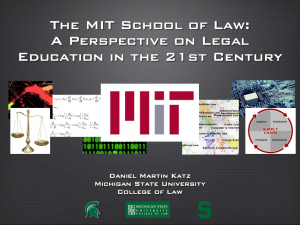 The first step to recovery is admitting that you have a problem. So, it is time for the academy to look in the mirror and admit it – we have a problem. The return on investment (ROI) of a J.D. is waning and reform is needed before the system collapses (via the reform in student loan market). The ROI is not really within the control of any particular institution. What institutions control is the curriculum and it is fair to say that the curriculum offered at most institutions is in need of a serious reboot.
The first step to recovery is admitting that you have a problem. So, it is time for the academy to look in the mirror and admit it – we have a problem. The return on investment (ROI) of a J.D. is waning and reform is needed before the system collapses (via the reform in student loan market). The ROI is not really within the control of any particular institution. What institutions control is the curriculum and it is fair to say that the curriculum offered at most institutions is in need of a serious reboot.
Larry Ribstein has appropriately described the American Legal Academy as a hothouse. I could have not said it better. Indeed, some strange plants have grown in here (with the insulation from market pressures). Those plants could not survive if subjected to a well functioning market for legal education.
Lets just get this out the way right now – there is less humanities in law’s future. I have nothing against the humanities but this is no longer a humanities age (other than this). It is an age of technology. Law school needs to transition from its liberal arts predisposition to a polytechnic research and teaching operation. From both a scholarship and training perspective, it is time to get serious about science, computation, data analytics and technology. I have argued that the arbitrage opportunity in the market for legal education is for an institution(s) the move toward an “MIT School of Law.” An MIT style institution would do just fine in the market for legal education. If you are an employer – hiring a lawyer for the 21st Century – please ask yourself this question: do you want a student from an MIT Style institution or some sort of liberal arts school? Of course, the market will ultimately decide this question — but I would place my bet with MIT.
Lets be clear about one other thing – better training is not likely to create more overall law jobs. If anything the future of law is going to have fewer (and very different lawyers). To better serve our students, we need real competition between schools (instead of blind mimicry of HLS/YLS). The “T14 schools” and the T14 wannabes suffer from the market dominance problem – they are typically too conservative to engage in serious innovation. Other than George Mason (back in the day) there are very few institutions they have played — Moneyball: The Law School Edition. There are notable exceptions but it difficult for those who were rewarded from a particular ordering to then turn around and see the illegitimacy / temporal properites of that ordering.
By the way, other than Michigan Law (where I got my J.D.), I really do not care what these other schools do. If the rest of them what to keep on believing that everything is cool – they can go right ahead. Just please understand that I will use this fact to beat up on them when it comes to recruiting students, etc. It will sort of go like this: “Let me just tell you as plainly as I can — they (some other unnamed school) just does not get it. They are stuck in another world – an analog world. If you go to ______ School of Law you simply are not going to get the quality of forward looking training we can offer here. Please do your research and when you do I think you will see that we are the institution that is ahead of the curve.”
(3) Realistically Positioning Oneself For Future Success in the Market For Legal Services
Students do carry some of the blame here. They are far from realistic about their position in the market for legal services and thus pursue coursework and training for which there is limited (zero) labor market payoffs. This happens at every institution, every year and has been going on for a very long time. I know a number folks at various schools that actually offer really good elective courses. You know – the types of elective courses that would allow students to gain useful skills. Many of them have difficulty filling their classes. The “I did not go to Law School to do Math” pathology runs deep.
Given the cost of tuition and the rapidly declining state of legal employment market – the cost of this myopic behavior has become extremely high. The open question for each institution is how much paternalism they should impose to help students (who are often operating at a serious information deficit) make choices that serve their long term interests?
(4) Note: The English (and Canadian System) Are Actually Under Extreme Pressure
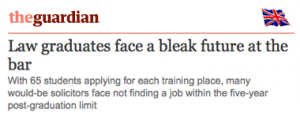 While in general I appreciate the rejoinder offered by Brian Leiter, he is slightly incorrect about the situation in the UK. There is an employment crisis there as well. Indeed, for a glimpse of the problem, please check out this past Friday November 25, 2011 Column “Law Graduates Face a Bleak Future at the Bar” from The Guardian. Actually, it worth noting that a similar crisis exists in Canada — see Law Profession Faces an ‘Articling Crisis’ from The Globe and Mail.
While in general I appreciate the rejoinder offered by Brian Leiter, he is slightly incorrect about the situation in the UK. There is an employment crisis there as well. Indeed, for a glimpse of the problem, please check out this past Friday November 25, 2011 Column “Law Graduates Face a Bleak Future at the Bar” from The Guardian. Actually, it worth noting that a similar crisis exists in Canada — see Law Profession Faces an ‘Articling Crisis’ from The Globe and Mail.
The UK and Canada are in a bad spot (although the regulatory changes in the UK may help them recover quicker). This is not exclusively legal education’s fault as some of this is certainly the recession. The issue is both (1) the recession (hopefully short term) and (2) technology (the long term problem). Law schools should pivot to teach their students to understand the technology infused law business of the 21st Century. Technology is not everything but it is likely over the coming decades to seriously redefine a non-trivial # of the current law jobs .
I am happy to be proven wrong (seriously – it would make my life much easier) but I would argue that the our method of training is in part responsible for the depth of the problem we face. While the use of case method has declined over the past decades, it still holds significant sway over the pedagogy of the modern legal academy.
What is the solution? What is the positive agenda? What a stockbroker tells you is the idea you should carry into this domain – diversification. Since we are in a turbulent period and do not quite know what the future holds, law schools and law students need to diversify their skills offerings — legal training + ( formal logic, supply chain mgmt, economics, project mgmt, data science, computation & info tech, decision theory, legal informatics, etc.) Excessive reliance one form of skill development (i.e. the case method) makes it harder for graduates to pivot when the labor market demand both shrinks and changes (as it has since ~2007). The available evidence indicates a change in demand is in the direction of hybrid skills (skill blending of law and __ variety)
From the NY Times, “Even after the economy recovers, the outsourcing of legal work from law firms and corporate counsel offices to lower-fee operations overseas is likely to continue.” This is true. We have a global legal supply chain and many of the law jobs of the future will involve managing that supply chain and contributing value to that supply chain.
(5) Dear Mr. Segal – It Turns Out that Power Law Distributions Are Ubiquitous
 There is a wide variety of interdisciplinary work in the legal academy – from the über serious to the downright nonsensical. The serious stuff and serious people will ultimately connect what the market values. I stayed out of the Segal NY Times piece largely because I felt that others had offered an adequate response to some of the problems associated with the article. However, I do want to make one important point about the citation distribution that he briefly discusses in the article.
There is a wide variety of interdisciplinary work in the legal academy – from the über serious to the downright nonsensical. The serious stuff and serious people will ultimately connect what the market values. I stayed out of the Segal NY Times piece largely because I felt that others had offered an adequate response to some of the problems associated with the article. However, I do want to make one important point about the citation distribution that he briefly discusses in the article.
Thomas Smith’s 2007 Article “The Web of the Law” is an instant classic. It was way ahead of its time and was probably missed by many law review editors and law professors because it was so novel (see also the math aversion discussion above). Yes, it turns out that citations to law reviews roughly follow a power law distribution (physics folks please do not yell at me – it is power law with a cutoff / extremely skewed / roughly 2< α <3). You know what else follows a power law or other related distribution – tons of things. In turns out, there is absolutely NOTHING unique of the patterns of citation that we observe in law. It is a pattern that is ubiquitous to a wide class of social and physical phenomena. Thus, the idea that many things have not been heavily cited is not a particularly useful point in an argument about the value or non-value of legal scholarship. Please see my discussion of power laws and positive legal theory, etc. in these posts (here) (here) and (here). See also my former Professor Lada Adamic’s tutorial (here).
(6) The Michigan State University Solution – 21st Century Law Practice Program
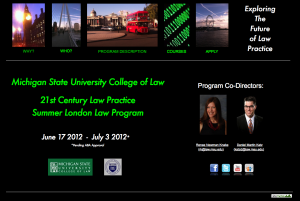 Here at Michigan State University – College of Law we have already begun to pivot. Next semester, I am teaching a version of Quantitative Methods that is infused with information technology, etc. (see discussion here). Summer 2012 we will be offering a summer program called 21st Century Law Practice – London Summer Program.
Here at Michigan State University – College of Law we have already begun to pivot. Next semester, I am teaching a version of Quantitative Methods that is infused with information technology, etc. (see discussion here). Summer 2012 we will be offering a summer program called 21st Century Law Practice – London Summer Program.
Here are the Three Courses for the 2012 Edition:
Legal Information Engineering & Technology
21st Century Law Practice
The Legal Services Act and UK Deregulation
Here is program description: “The MSU/Westminster 21st Century Law Practice London Summer Program is a first of its kind, intensive study of technology, innovation, regulation, entrepreneurship and the international legal marketplace. With the deregulation of lawyers in the United Kingdom and the outgrowth of alternative legal services delivery models, London is poised to become the global leader in the legal services market. Our program will educate students about these new delivery models and help prepare students for the technology infused law jobs of the 21st Century.”
The 21st Century Law Practice program has three main educational objectives:
(1) Provide students a comprehensive understanding of the market for legal services as it transitions to a global legal supply chain in the wake of deregulation, economic pressures, and technological innovation.
(2) Prepare students to become practice-ready entrepreneurial lawyers who can leverage information technology in order to operate more efficiently and to attract (and retain) clients.
(3) Inspire students to think broadly about future delivery of legal representation and access to justice by exposing them to the innovative legal service delivery models and platforms of the present (and not-too-distant future).
(7) Forgive Me Science For I Have Sinned – Bridging the Scientific Legal Scholarship and Law Practice Divide?
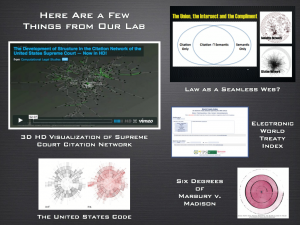 The academic study of law can be a serious scientific exercise — and yeah this science can directly inform modern law practice. Indeed, one of the major goals in starting this blog was to demonstrate this proposition. The lawyer of the future needs to be able to leverage technology to practice law an efficient manner. The science and engineering that is needed is the type that would be pursued at an “MIT Style School of Law.” Tech transfer, legal R&D is one of the things that the law school of the future can do to aid law practice. This (among other things) could help restore some of the value proposition and help foster much needed innovation in the market for legal services.
The academic study of law can be a serious scientific exercise — and yeah this science can directly inform modern law practice. Indeed, one of the major goals in starting this blog was to demonstrate this proposition. The lawyer of the future needs to be able to leverage technology to practice law an efficient manner. The science and engineering that is needed is the type that would be pursued at an “MIT Style School of Law.” Tech transfer, legal R&D is one of the things that the law school of the future can do to aid law practice. This (among other things) could help restore some of the value proposition and help foster much needed innovation in the market for legal services.
What it means to practice law and “think like a lawyer” is not a static proposition.
As Law Schools – we better get to the future — before the future gets to us : )
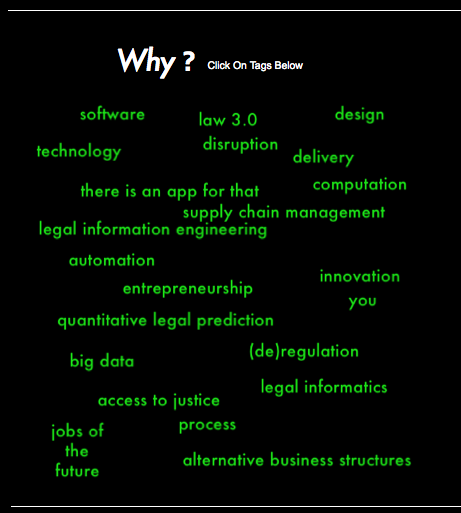 Courses for the 2012 Program:
Courses for the 2012 Program:
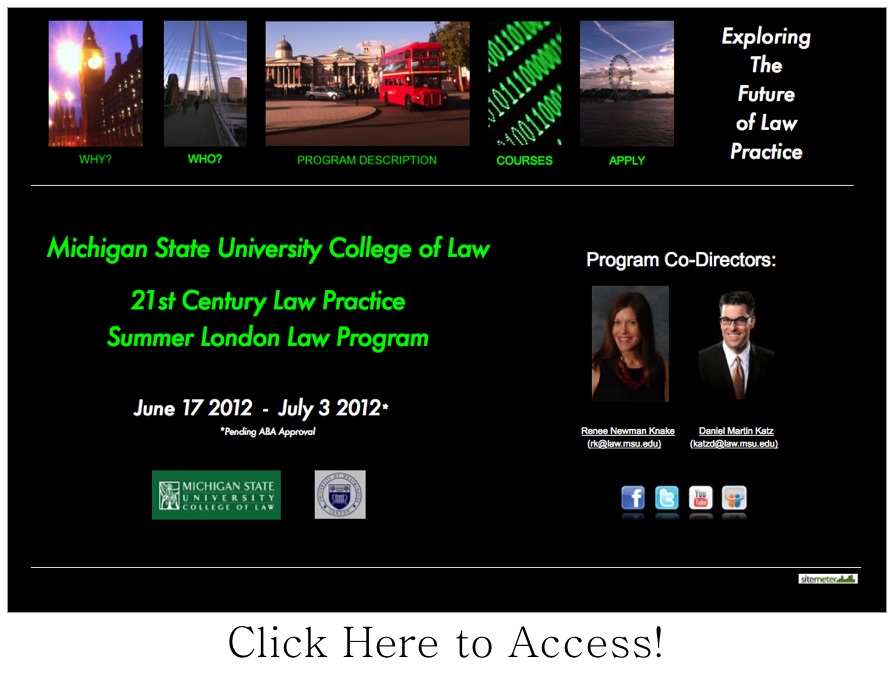
 I am a bit torn by all of this. In general, I think the
I am a bit torn by all of this. In general, I think the 





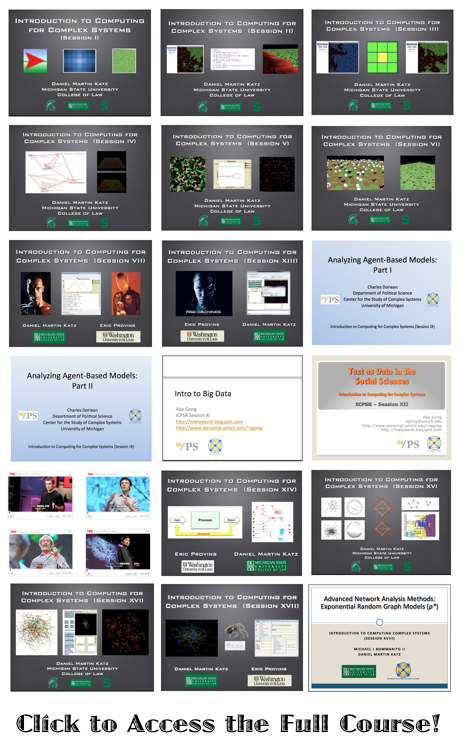
 Ask a typical lawyer how informatics affects their practice, and, if you’re lucky, they might mention that salary infographic their friend emailed them a few weeks ago. Data, modeling, statistics, and visualization might be seen as cute toys, but not real tools. Ask a typical lawyer how search affects them, however, and they’ll have no trouble producing a list of five-figure-per-seat services like
Ask a typical lawyer how informatics affects their practice, and, if you’re lucky, they might mention that salary infographic their friend emailed them a few weeks ago. Data, modeling, statistics, and visualization might be seen as cute toys, but not real tools. Ask a typical lawyer how search affects them, however, and they’ll have no trouble producing a list of five-figure-per-seat services like  The second category is best understood through a hope and a struggle:
The second category is best understood through a hope and a struggle:  What can we do in the meantime while our robotic overlords are still incubating? How can we improve the quality and cost of law despite the constraints of our weak, organic bodies and slow-moving societies? I’d like to argue that the way forward is through 21st century law, not 20th or 22nd century law, as identified by the principles below:
What can we do in the meantime while our robotic overlords are still incubating? How can we improve the quality and cost of law despite the constraints of our weak, organic bodies and slow-moving societies? I’d like to argue that the way forward is through 21st century law, not 20th or 22nd century law, as identified by the principles below: